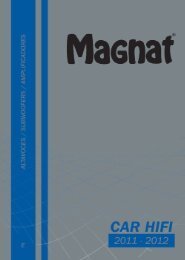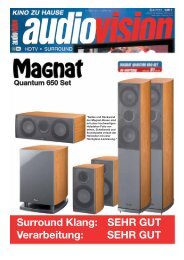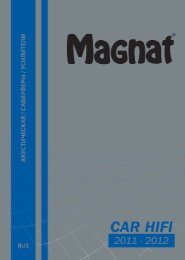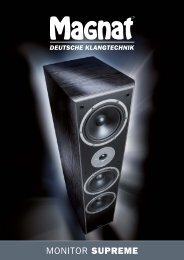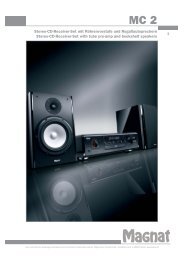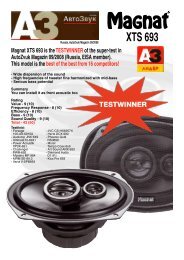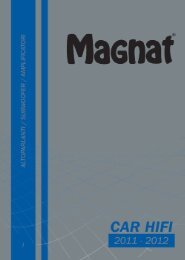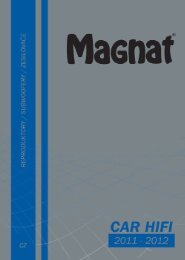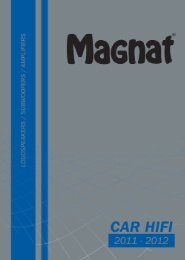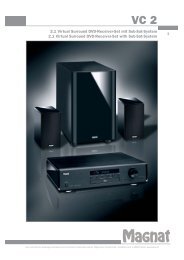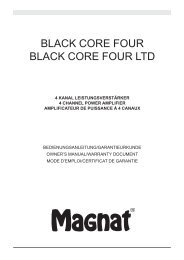New Edge 216 Price/performance TOP CLASS positive ... - Magnat
New Edge 216 Price/performance TOP CLASS positive ... - Magnat
New Edge 216 Price/performance TOP CLASS positive ... - Magnat
You also want an ePaper? Increase the reach of your titles
YUMPU automatically turns print PDFs into web optimized ePapers that Google loves.
+<br />
+<br />
+<br />
-<br />
<strong>positive</strong> sound<br />
high maximum level<br />
high quality workmanship<br />
/<br />
<strong>TOP</strong> <strong>CLASS</strong><br />
<strong>Price</strong>/<strong>performance</strong><br />
<strong>New</strong> <strong>Edge</strong> <strong>216</strong>
<strong>TOP</strong> <strong>CLASS</strong><br />
<strong>Price</strong>/<strong>performance</strong><br />
<strong>New</strong> <strong>Edge</strong> <strong>216</strong><br />
The 16cm <strong>New</strong> <strong>Edge</strong> <strong>216</strong> speaker from<br />
<strong>Magnat</strong> is attractive with a flow-optimised<br />
design. What about the aerodynamics?<br />
When setting up home speakers it is entirely<br />
self-evident: the sound is meant to travel to<br />
the ear as directly as possible, without being<br />
hindered by objects which could distort the<br />
sound pattern. The same problems are evident<br />
in a vehicle: everything lying between<br />
the cone and the ear influences the sound.<br />
But this piece of acoustic wisdom isn‘t everything.<br />
While the front of the cone gives free<br />
rein to the sound, things don‘t appear quite<br />
so rosy at the rear. Here the basket, magnet,<br />
voice coil, pole plate and connections<br />
obstruct the path of the sound. This realisation<br />
is not new by any means, but the developers<br />
from <strong>Magnat</strong> have now addressed<br />
the problem. This has resulted in the speakers<br />
and subwoofer of the <strong>New</strong> <strong>Edge</strong> series<br />
becoming more aerodynamic. The result of<br />
the engineers‘ efforts is termed ‚Air Flow<br />
Technology‘ (in short: AF Tech). We ordered<br />
the 16cm <strong>New</strong> <strong>Edge</strong> <strong>216</strong> speaker system<br />
for around 300 Euro and put it to the test.<br />
The woofer of the 2-way component system<br />
comes with five, almost graceful looking<br />
supports. Its visual profile is modelled on<br />
that of rotor blades: these are arranged on<br />
both sides in order to allow the air to flow<br />
unhindered and with as little swirl as possible.<br />
This is completely in keeping with<br />
the motto: as much as necessary, but as<br />
little as possible. The basket offers sufficient<br />
free space behind the centre spider and it is<br />
open on all sides, which also enables the air<br />
to circulate freely without any obstructions.<br />
This also allows the heat to be removed<br />
and dissipated by the 15 cooling fins that<br />
are positioned on the rear plate. In addition<br />
to the many technical features there is<br />
certainly something for the eye to behold.<br />
The bezel of the die-cast basket is turned<br />
and processed in a glossy silver finish and<br />
the dark chrome-plated pole plates are also<br />
very attractive. And the aluminium cone has<br />
a light-grey ceramic coating, which provides<br />
better resonance damping. The wide<br />
rubber surround enables a large excursion,<br />
which is necessary for the production<br />
of high sound pressure. These fine touches<br />
really pay off: the autohifi laboratory<br />
TEST factory confirms a maximum<br />
sound pressure for the <strong>New</strong> <strong>Edge</strong> woofer<br />
of around 98 decibels at 50 Hz. This kind<br />
of level has only been created previously<br />
with a crammed-full chassis. At 90 Hz the<br />
woofer produces a level slightly above 103<br />
decibels. The bottom line is a considerable<br />
16 points for the maximum level.<br />
Open Air: 15 cooling fins positioned in front of the<br />
pole plate absorb the heat from the coil.
The tweeter with its turned aluminium edging<br />
and stylish honeycomb grille looks very<br />
appealing. It has a mature, 25 mm fabric<br />
cone. The dome shape goes under the<br />
name „Canternary“, which depicts an arc<br />
with an inconsistent radius. „This can be<br />
envisaged like a sagging chain“, proclaims<br />
the figurative explanation from product manager<br />
Nic König. This should enable cone<br />
resonance to be repressed. The dome has<br />
a small flange-mounted coupling volume,<br />
which ensures a low resonance frequency.<br />
The <strong>Magnat</strong> engineers have dispensed with<br />
the conventional cooling ferrofluid in the air<br />
gap. The speaker specialist accepts the lower<br />
load capacity in favour of a more impulsive,<br />
undamped sound rendition. In terms of<br />
measurement the tweeter has a more pronounced<br />
resonance frequency, which could<br />
have a negative effect on the crossover. But<br />
the engineers at <strong>Magnat</strong> have done their<br />
homework and provided the high-pass filter<br />
with an absorption circuit to linearise impedance.<br />
An LRC element is arranged in the<br />
crossover parallel to the tweeter connection<br />
for this very purpose; i.e. a resistor, a capacitor<br />
and a coil in series, which reduces<br />
the impedance peak that is co-ordinated<br />
with the resonance frequency of the tweeter<br />
at 1400 Hz. The crossover, however,<br />
has even more to offer beneath its attractive<br />
aluminium panel. The tweeter can resort to<br />
three different sound level settings and, on<br />
top of everything, it also possesses a jumper,<br />
which increases the level in the super<br />
high range. In terms of sound it provides<br />
more „glitz“ when suited. The low-pass filter<br />
also has a small circuit, whose purpose is<br />
to steady the cone resonance of the woofer<br />
at around 4.5 kHz. The mid-tone range<br />
can also be lowered in the car if necessary.<br />
While a normal 12 decibel crossover manages<br />
on four components, the extras on the<br />
<strong>Magnat</strong> unit produce the same as 15. Despite<br />
this nothing has been compromised in<br />
terms of quality: all capacitors consist of<br />
high-quality metallised polyester films<br />
and all resistors are manufactured from<br />
low-inductance metal oxide. The air core<br />
coils in the treble range are distortion-free<br />
and the inductance in the low-pass can<br />
also be observed. All in all the <strong>New</strong> <strong>Edge</strong><br />
<strong>216</strong> marketed by Audiovox produces a<br />
well-rounded, high quality impression,<br />
which would be perfectly acceptable for<br />
speaker systems costing twice as much.<br />
After this early praise the <strong>Magnat</strong> speaker<br />
had to compete with test references in the<br />
listening area. The playback was fresh and<br />
lively. The brilliant tweeter didn‘t omit<br />
any detail and avoided over-exaggerating<br />
any aspect. In the bass test the <strong>New</strong><br />
<strong>Edge</strong> <strong>216</strong> did not completely live up to the<br />
liveliness of the 28-point reference system<br />
‚Syrincs Cryor 62‘, however it did produce<br />
more force and depth and, thanks to its<br />
spirited playback, achieved an extra point,<br />
which meant: 29 sound points. The aerodynamics<br />
of the woofer also bore fruit with regard<br />
to maximum levels, which merely adds<br />
to the overall high-quality of the components<br />
that you get for the favourable price.<br />
Variable: the crossover offers several setting possibilities<br />
for the woofer and tweeter. It has been manufactured<br />
from particularly high-quality elements.



